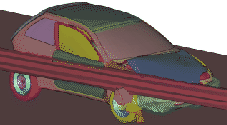
engineering & technology publications
ISSN 1759-3433
PROCEEDINGS OF THE SEVENTH INTERNATIONAL CONFERENCE ON COMPUTATIONAL STRUCTURES TECHNOLOGY
Computational and Experimental Full-Scale Crash Analysis of a Road Safety Barrier
Faculty of Mechanical Engineering, University of Maribor, Slovenia
The paper describes the computational analysis and experimental crash test of newly developed road safety barrier. The purpose of this research was to build an adequate computational model of the road safety barrier and to validate the computational results with a real crash test.
The main parts of the road safety barrier are: the guardrail (W-shaped metal sheet), the distance spacer and the posts. All parts are connected with bolts, while posts are rammed into the soil to the depth corresponding to 2/3 of its length. All elements of the evaluated road safety barrier are made of construction steel S 235 (St 37-2 according to DIN).
The deformation pattern, stiffness and impact severity of the new design have been evaluated with the dynamic nonlinear analyses of the three-dimensional road safety barrier within the framework of the finite element method with LS-DYNA code [1]. Previously experimentally determined dynamic material response parameters were considered in all computational analyses. Response of the soil around the rammed posts was simulated with a network of visco-plastic springs attached to the part of the posts rammed into the soil. Vehicle impact conditions were set in accordance with EN 1317 regulations for a target vehicle containment level [2].
Average vehicle impact severity is usually measured with evaluation of the maximum impact severity index (ASI). ASI is a measure of vehicle accelerations during impact, which is evaluated over a moving interval of 50 ms and normalised with allowable accelerations in all three longitudinal axes of vehicle motion. If maximum ASI value exceeds 1,0 or 1,4 in some cases, then it is considered that the consequences of an impact for the passengers are dangerous or even lethal.
Computational simulations have shown that extreme decelerations of the vehicle mass centre occur during initial vehicle impact at the guardrail and later when the vehicle hits the post. ASI index was well bellow the safety limit and was the highest when the front wheel hit the first post. Simulations have also clearly proved that appropriate distance spacer design through its controlled deformation significantly reduces the decelerations experienced by vehicle occupants in the initial phase of an impact (Figure 1) [3,4].
The new road safety barrier was tested in a full scale crash test at TÜV Automotive test facility in Germany according to the EN 1317 standard. The road restraint system tests were successful in properly redirecting the test vehicles back on the road without collapsing. Measured deformations and vehicle decelerations corresponded well with computational predictions, which in turn validated correctness of the used computational model.
The new computational model can be applied for optimisation of other road safety barriers and prediction of their behaviour under real impact conditions of different vehicles.
- 1
- Livermore Software Technology Corporation, "LS-DYNA Theoretical Manual", 1998.
- 2
- European Committee for Standardization, "European Standard EN 1317-1, EN 1317-2, Road Restraint Systems", 1998.
- 3
- Vesenjak M., Ren Z. "Computer-aided design of a road restraint barrier", J of Mech Engng, Vol 49, No 10, pp 509-519, 2003.
- 4
- Vesenjak M., Ren Z. "Dynamic analysis of a road restraint system's deformation resulting from a vehicle impact", J of Mech Engng, Vol 49, No 12, pp 586-592, 2003.
purchase the full-text of this paper (price £20)
go to the previous paper
go to the next paper
return to the table of contents
return to the book description
purchase this book (price £135 +P&P)
